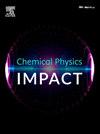高效DSSCs用D-A1-π-A染料增敏剂中给体和内受体对光伏参数影响的研究
IF 3.8
Q2 CHEMISTRY, PHYSICAL
引用次数: 0
摘要
在染料敏化太阳能电池(DSSCs)中,光电转换的效率受到染料分子中供体和内部受体单位的选择的显著影响。在本研究中,我们设计并研究了供体群和内部受体单位对强调DSSCs性能的影响。用最高已占据分子轨道(HOMO)、最低未占据分子轨道(LUMO)、HOMO-LUMO能隙(HLG)、激发态氧化势(Edye*)、电子注入自由能(Ginj)和开路电压(VOC)等光伏参数评价了D-A1-π-A体系的性能。DFT和TDDFT方法用于检查染料的电子特性,包括电荷转移动力学、能隙和光伏参数,并确定这些组合如何影响光吸收、电子注入和整体电池效率。研究结果表明,D-A1-π-A结构染料增强了309 ~ 523 nm范围内的光吸收光谱,使电子更有效地转移到TiO2半导体上,提高了整体电池效率。在所研究的染料中,含有取代咔唑和苯并三唑单元的R4染料在JSC值为15 mA cm-2时的效率最高,为4.48%。因此,该研究显示了有机染料分子设计的重要性,并为下一代太阳能染料的开发提供了见解。本文章由计算机程序翻译,如有差异,请以英文原文为准。

Investigation of the influence of donor and internal acceptor on photovoltaic parameters in D-A1-π-A Dye sensitizers for efficient DSSCs
In dye-sensitized solar cells (DSSCs), the efficiency of light-to-electricity conversion is significantly influenced by the choice of donor and internal acceptor units in the dye molecules. In this study, we have designed and investigated the impact of donor groups and internal acceptor units for emphasizing the performance of DSSCs. The performance of the D-A1-π-A system has been evaluated in terms of various photovoltaic parameters such as the highest occupied molecular orbital (HOMO), lowest unoccupied molecular orbital (LUMO), HOMO-LUMO energy gap (HLG), excited-state oxidation potential (Edye*), free energy of electron injection (Ginj), and open-circuit voltage (VOC). DFT and TDDFT methodology is used to examine dye's electronic properties, including charge transfer dynamics, energy gaps, and photovoltaic parameters and to determine how these combinations influence light absorption, electron injection, and overall cell efficiency. Our findings indicate that D-A1-π-A architectural dyes enhance light absorption spectra ranging from 309 nm to 523 nm with variation in donor and acceptor groups and facilitating more effective electron transfer to the TiO2 semiconductor and enhancing the overall cell efficiency. Among all the studied dyes, the R4 dye containing substituted carbazole and benzotriazole unit shows a maximum efficiency of 4.48 % at a JSC value of 15 mA cm-2. Hence, this research showed the importance of molecular design of organic dyes and provided insights into the development of next-generation dyes for solar energy applications.
求助全文
通过发布文献求助,成功后即可免费获取论文全文。
去求助
来源期刊

Chemical Physics Impact
Materials Science-Materials Science (miscellaneous)
CiteScore
2.60
自引率
0.00%
发文量
65
审稿时长
46 days
 求助内容:
求助内容: 应助结果提醒方式:
应助结果提醒方式:


